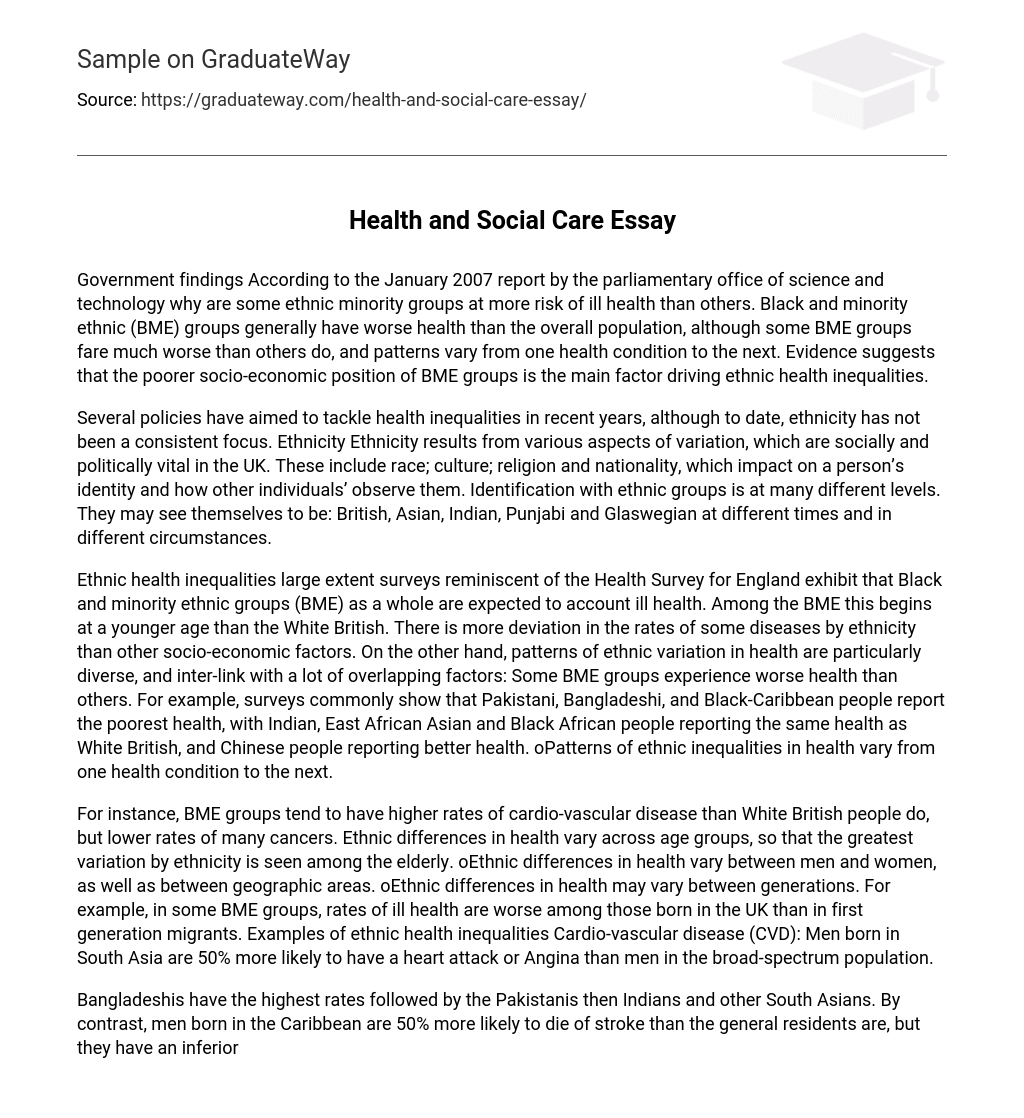Government findings According to the January 2007 report by the parliamentary office of science and technology why are some ethnic minority groups at more risk of ill health than others. Black and minority ethnic (BME) groups generally have worse health than the overall population, although some BME groups fare much worse than others do, and patterns vary from one health condition to the next. Evidence suggests that the poorer socio-economic position of BME groups is the main factor driving ethnic health inequalities.
Several policies have aimed to tackle health inequalities in recent years, although to date, ethnicity has not been a consistent focus. Ethnicity Ethnicity results from various aspects of variation, which are socially and politically vital in the UK. These include race; culture; religion and nationality, which impact on a person’s identity and how other individuals’ observe them. Identification with ethnic groups is at many different levels. They may see themselves to be: British, Asian, Indian, Punjabi and Glaswegian at different times and in different circumstances.
Ethnic health inequalities large extent surveys reminiscent of the Health Survey for England exhibit that Black and minority ethnic groups (BME) as a whole are expected to account ill health. Among the BME this begins at a younger age than the White British. There is more deviation in the rates of some diseases by ethnicity than other socio-economic factors. On the other hand, patterns of ethnic variation in health are particularly diverse, and inter-link with a lot of overlapping factors: Some BME groups experience worse health than others. For example, surveys commonly show that Pakistani, Bangladeshi, and Black-Caribbean people report the poorest health, with Indian, East African Asian and Black African people reporting the same health as White British, and Chinese people reporting better health. oPatterns of ethnic inequalities in health vary from one health condition to the next.
For instance, BME groups tend to have higher rates of cardio-vascular disease than White British people do, but lower rates of many cancers. Ethnic differences in health vary across age groups, so that the greatest variation by ethnicity is seen among the elderly. oEthnic differences in health vary between men and women, as well as between geographic areas. oEthnic differences in health may vary between generations. For example, in some BME groups, rates of ill health are worse among those born in the UK than in first generation migrants. Examples of ethnic health inequalities Cardio-vascular disease (CVD): Men born in South Asia are 50% more likely to have a heart attack or Angina than men in the broad-spectrum population.
Bangladeshis have the highest rates followed by the Pakistanis then Indians and other South Asians. By contrast, men born in the Caribbean are 50% more likely to die of stroke than the general residents are, but they have an inferior mortality to coronary heart disease. Classical risk factors like smoking; blood pressure; obesity; and cholesterol fall short to explanation for all these national variations, and there is discussion regarding how much they can be explained by socio-economic factors.
Many researchers think that there are biological differences between ethnic groups, and an assortment of a investigate has been carried out on the potential mechanisms. Cancer Overall, Cancer rates tend to be lower in BME groups. For lung cancer, mortality rates are lower in people from South Asia, the Caribbean and Africa, which relates to lower levels of smoking. The highest mortality is found in people from Ireland and Scotland. Mortality from breast cancer is lower for migrant women than for women born in England and Wales.
Researchers think this reflects the fact that it takes time to acquire the detrimental lifestyle and other risk factors associated with living in this country. Mental health Ethnic differences in mental health are controversial. Most of the data are based on treatment rates, which show that BME people are much more likely to receive a diagnosis of mental illness than the White British. Studies show up to 7 times higher rates of new diagnosis of psychosis among Black Caribbean people than among the White British. Risk factors
The higher death rate of men can be simultaneous with other high levels of cigarette, smoking and drinking by men, and their contribution in more risky and dangerous sports and other activities. Economic inequalities regardless of changes in the law, women still receive less income than men. According to the Equal Opportunities Commission ( in 2005) ‘Almost 30 years after the Equal Pay Act made it illegal to pay women less for doing the same job, a pay gap of 18% still exists between women and men working full-time. A higher proportion of women than men are in low-paid part-time work; they are far more likely to be on state means-tested benefits. In older age they are more likely to be in deficiency for the reason that they are less likely to have employer’s pension and may not, because of family responsibilities, have a full state pension either. There are clear and undeviating links between poverty and poor health. The female role Women still take the responsibility for the housework in most homes. The higher incidence of depression may be linked with the dull repetitive nature of the work.
Popay and Bartley (1998), studying the hours spent on domestic labour in 1700 households in London, found that women spent up to 87 hours per week on housework and that women with children spent 64 hours per week even if they had a full-time job. Often women will be managing on an inadequate resources, working long hours and have little time to and for themselves. However, it may be that the higher rates of diagnosed stress-related illness for women are due to the willingness of women to discuss mental health issues with their doctor rather than there actually being a higher rate of stress-related illness.





